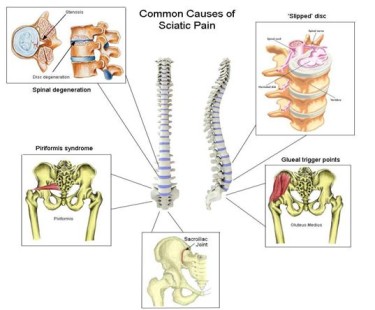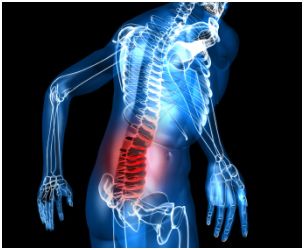What is Sciatica ?
The sciatic nerve is the longest nerve in your body. It runs from your pelvis, through your hip area and buttocks and down each leg. The sciatic nerve branches into smaller nerves as it travels down the legs providing feeling to your thighs, legs, and feet as well as controlling many of the muscles in your lower legs. The term sciatica refers to pain that radiates along the path of this nerve.

Sciatica
What Causes Sciatica?
Sciatica is actually a sign that you have an underlying problem putting pressure on a nerve in your lower back. The most common cause of this nerve compression is a bulging or herniated lumbar disc. Piriformis syndrome is another common cause of sciatica.
The Piriformis is a muscle that lies directly over the sciatic nerve. If this muscle becomes tight or if you have a spasm in this muscle, it puts pressure directly on the sciatic nerve.
Occasionally, sciatic pain in men is caused by sitting on a wallet.

Symptoms
Pain that radiates from your lower (lumbar) spine to your buttock and down the back of your leg is the hallmark of sciatica.
Sciatica may be accompanied by numbness, tingling, and muscle weakness in the affected leg. This pain can vary widely, from a mild ache to a sharp, burning sensation or excruciating discomfort. Sometimes it may feel like a jolt or electric shock.
Sciatic pain often starts gradually and intensifies over time. It’s likely to be worse when you sit, cough or sneeze.

Sciatica pain
Treatment
The goals of sciatica treatments are to relieve pain and any neurological symptoms caused by a compressed nerve root. There is a broad range of options available for sciatica treatment. One or some combination of the treatments below is usually recommended in conjunction with specific exercises.
- Heat/Ice
- Pain Medications
- Epidural Steroid Injections for Sciatica
- Physiotherapy
- Surgery
Low Level Laser Therapy Treatment for Sciatica
Low Level Laser Therapy (LLLT) is the application of red and near infrared light over injuries to stimulate cellular repair. LLLT has a powerful anti-inflammatory effect as well as a healing effect. LLLT is completely safe and has no effect on normal tissues.
Application of LLLT over affected site (Piriformis muscle) helps in triggering an autoimmune response in the body which stimulates the damaged cells and promotes rapid healing and repair. Once normal immune processes are restored, the excessive inflammation is reduced and healing can begin.
You will be encouraged to move the affected area within range of movement/pain but not exert stretch or force during the healing phase.
The end result is resolution of inflammation and restoration of healthy tendons and local soft tissues. Once tissues are healed, pain is eliminated and normal range of motion and function is restored. Then muscle and tendon strength and flexibility can be addressed with graduated exercises and stretching.
LLLT has no known side effects, is safe and effective. By treating the underlying problem, LLLT results in permanent pain relief and restoration of function.

